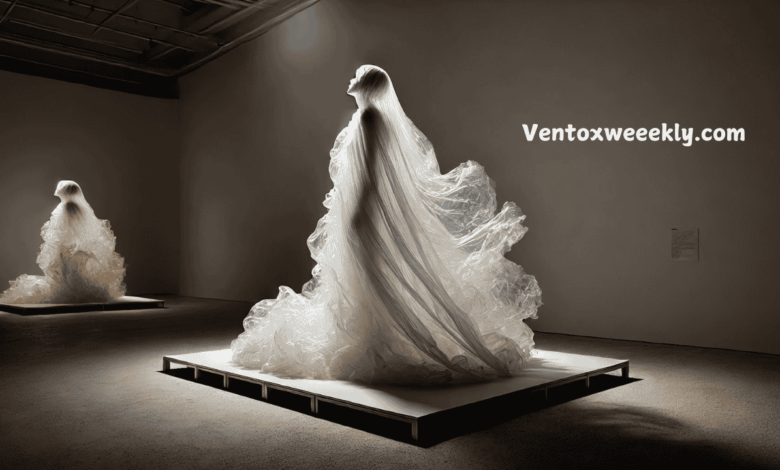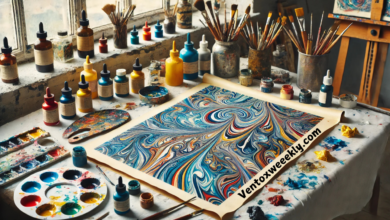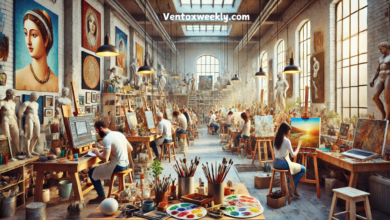https://multigrafico.com/khalil-chishtee-no-todo-el-arte-es-belleza/

Art often associates beauty with symmetry, perfection, and traditional materials. However, artists like Khalil Chishtee challenge these conventions by finding elegance in unexpected places. The Pakistani-born artist has gained attention for his creative sculptures made primarily from plastic bags. In his work, Chishtee offers a unique perspective on art, demonstrating that beauty can arise from unconventional materials and that art can evoke profound emotions without fitting traditional standards.
Who is Khalil Chishtee?
Khalil Chishtee is a sculptor and artist from Pakistan who has been creating art for over two decades. He is best known for his ability to transform trash bags and other discarded materials into powerful, thought-provoking sculptures. While his work has ecological undertones due to the use of recycled materials, his main focus is not environmental activism. Instead, Chishtee’s sculptures delve into more profound, personal themes such as identity, human emotion, and existential experiences.
Chishtee’s work has been exhibited worldwide, bringing attention to his unique medium and the stories and feelings embedded in each piece. His approach to art defies the notion that only classical materials like marble, bronze, or wood can be used to create moving, beautiful works. Instead, he embraces the challenge of literally and metaphorically giving life to what others might discard.
The Philosophy Behind His Art
Chishtee’s mantra seems to be, “Not all art is beauty, and not all beauty is art.” By using materials like plastic bags, often seen as mundane or ugly, he forces viewers to reconsider their definitions of art and beauty. His sculptures usually depict human figures caught in stillness or motion moments, evoking emotions ranging from joy to melancholy. Plastic’s delicate, ethereal nature allows him to create almost ghost-like sculptures as if frozen in time.
The contrast between the fragility of the material and the strength of the emotions conveyed in his work speaks to his artistic vision. Chishtee believes in finding beauty in imperfection, and his art is a testament to how the imperfect and overlooked can tell powerful stories. His pieces are often described as poetic and haunting, challenging viewers to find meaning beyond the superficial.
Sculpting With Plastic: A Unique Medium
One of the most distinctive aspects of Chishtee’s art is his use of plastic bags. Unlike other sculptors who might work with clay, metal, or wood, Chishtee prefers plastic’s lightweight, translucent quality. The material allows him to create solid, ephemeral pieces with details that can shift depending on the light and the viewer’s perspective.
The choice of plastic bags is not purely aesthetic; it also reflects consumerism and waste. In many parts of the world, plastic bags are seen as disposable, but Chishtee gives them a second life, transforming them into something valuable and enduring. This act of repurposing aligns with broader themes of renewal, identity, and transformation, encouraging audiences to see the potential in everything around them.
Not Just About Recycling: Themes in Chishtee’s Work
While Chishtee’s choice of materials has led many to see him as an eco-artist, he clarifies that his work is not strictly about environmentalism. Instead, his sculptures explore universal themes of love, loss, longing, and human connection. He uses his art to capture moments that are relatable to everyone, whether it’s a figure standing in contemplation, two lovers intertwined, or a child looking up in wonder.
Chishtee’s work also delves into themes of cultural identity and the immigrant experience. Having moved from Pakistan to the United States, he understands the feeling of being in between cultures, and this sense of liminality often finds its way into his art. The plastic bags, which are light, flexible, and can be blown by the wind, are a perfect metaphor for identity’s transient, ever-shifting nature.
The Artistic Process
Creating sculptures out of plastic bags is no easy task. Each piece starts with an idea or a feeling that Chishtee wants to express. He then carefully moulds, twists, and layers the plastic to bring the figure to life. The procedure demands patience and a thorough grasp of the material, as plastic is less forgiving than traditional sculpting mediums. However, this makes Chishtee’s work compelling—the material’s fragility mirrors the human condition’s fragility.
In interviews, Chishtee has mentioned that he does not aim for perfection. Instead, he embraces the imperfections of working with such a flexible, unpredictable medium. This approach allows him to capture human emotions’ raw, unpolished nature.
Exhibitions and Global Recognition
Khalil Chishtee’s work has been showcased worldwide in art galleries, including Pakistan, the United States, and Europe. His art resonates with a broad audience because it speaks to universal experiences and emotions. Even though his sculptures are made from materials most people consider trash, they have been celebrated for their elegance and emotional depth.
These exhibitions have helped elevate the perception of non-traditional art materials, showing that anything, even a plastic bag, can be a conduit for profound artistic expression. Chishtee has proven that art is not about the materials used, but the message conveyed. His work encourages viewers to see beyond the surface, to find beauty in the unexpected, and to recognize the hidden stories that everyday objects can tell.
The Broader Impact: Challenging Perceptions
Khalil Chishtee’s sculptures do more than fill gallery spaces; they challenge perceptions of art, waste, and beauty. Using plastic, he invites conversations about consumerism, the environment, and what society deems valuable or disposable. His work has been particularly poignant in the context of increasing global concerns about plastic waste and the environment.
However, Christie doesn’t want his art seen as just an ecological statement. Instead, he uses the medium to convey that beauty can exist even in what society sees as ugly or worthless. This perspective can be applied not just to art but to life itself, encouraging people to see the value in things and people that might otherwise be overlooked.
Conclusion
Khalil Chishtee’s work represents a fusion of art, philosophy, and social commentary. Through his sculptures, he challenges the traditional notions of beauty and value, showing that art does not have to be made from precious materials to be powerful. His choice to use plastic bags is practical and symbolic, representing the potential for transformation and renewal.
FAQs on https://multigrafico.com/khalil-chishtee-no-todo-el-arte-es-belleza/
Who is Khalil Chishtee?
Khalil Chishtee is a Pakistani-born artist known for creating sculptures from plastic bags and recycled materials. His work explores themes of identity, emotion, and human experience.
What materials does Khalil Chishtee use for his sculptures?
Chishtee primarily uses plastic bags but works with other non-traditional materials like trash bags and discarded objects to create his art.
Are Khalil Chishtee’s works focused on environmental issues?
While his choice of recycled materials hints at ecological awareness, Chishtee’s art focuses on transformation, identity, and human emotions.
Where has Khalil Chishtee exhibited his work?
His sculptures have been displayed in galleries worldwide, including the United States, Pakistan, and Europe.
What themes are commonly found in Chishtee’s sculptures?
Chishtee’s art often explores themes of love, loss, cultural identity, and the transient nature of life.



